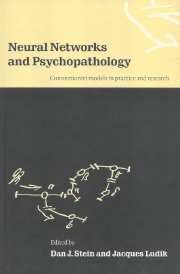Book contents
- Frontmatter
- Contents
- List of contributors
- Preface
- Part one General Concepts
- Part two Clinical disorders
- 7 The nature of delusions: a hierarchical neural network approach
- 8 ‘Produced by either God or Satan’: neural network approaches to delusional thinking
- 9 Neural network modelling of cognitive disinhibition and neurotransmitter dysfunction in obsessive–compulsive disorder
- 10 The fables of Lucy R.: association and dissociation in neural networks
- 11 Neural network analysis of learning in autism
- 12 Are there common neural mechanisms for learning, epilepsy, and Alzheimer's disease?
- Epilogue
- Index
10 - The fables of Lucy R.: association and dissociation in neural networks
from Part two - Clinical disorders
Published online by Cambridge University Press: 12 January 2010
- Frontmatter
- Contents
- List of contributors
- Preface
- Part one General Concepts
- Part two Clinical disorders
- 7 The nature of delusions: a hierarchical neural network approach
- 8 ‘Produced by either God or Satan’: neural network approaches to delusional thinking
- 9 Neural network modelling of cognitive disinhibition and neurotransmitter dysfunction in obsessive–compulsive disorder
- 10 The fables of Lucy R.: association and dissociation in neural networks
- 11 Neural network analysis of learning in autism
- 12 Are there common neural mechanisms for learning, epilepsy, and Alzheimer's disease?
- Epilogue
- Index
Summary
According to Aristotle, ‘to be learning something is the greatest of pleasures not only to the philosopher but also to the rest of mankind.’ But even as he affirms the unbounded human capacity for integrating new experience with existing knowledge, he alludes to a significant exception: ‘The sight of certain things gives us pain, but we enjoy looking at the most exact images of them, whether the forms of animals which we greatly despise or of corpses.’ Our capacity for learning is happily engaged in viewing representations of painful objects, but not, it seems, in viewing the objects themselves. When an experience is intensely painful, what then is a rational animal to do? We can neither disable our learning process, nor erase its traces. In the face of intense pain, horror, or terror, learning and remembrance cause no pleasure but rather persistent psychological pain and disruption. The memorious mind reverberates with trauma.
The traumatized mind responds in diverse ways to the recurrent crises of reminiscence, responses which lead at the extreme to the symptoms of various disorders. These reactions fall into two broad categories: the associative and the dissociative. The first is exemplified by some (but not all) of the symptoms of post-traumatic stress disorder, in cases in which even a trivial element associated with the painful event becomes an evocative cue for reliving the experience. In contrast, dissociation is characterized by subjective distancing from the initial pain and its remembrance, often with secondary effects. In dissociative amnesia, for example, subjects fail to recall critical spans of their lives, often seeming to obliterate the traumatic memory.
- Type
- Chapter
- Information
- Neural Networks and PsychopathologyConnectionist Models in Practice and Research, pp. 248 - 273Publisher: Cambridge University PressPrint publication year: 1998
- 1
- Cited by



